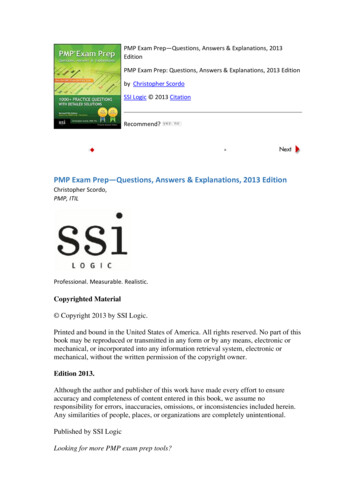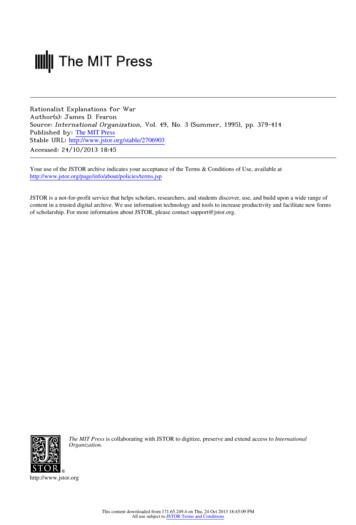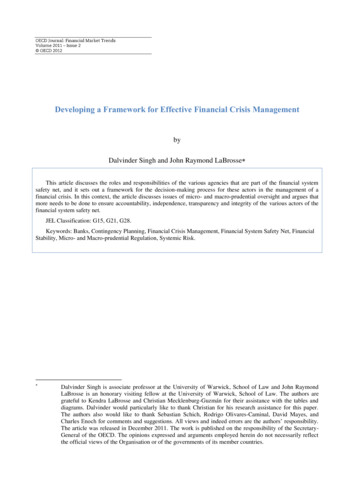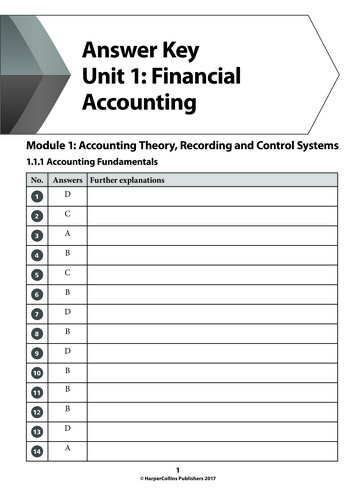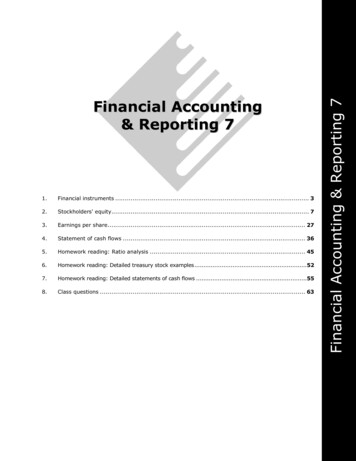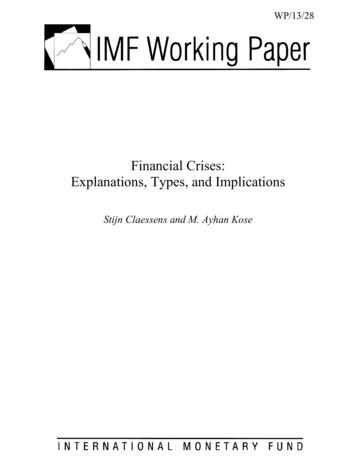
Transcription
WP/13/28Financial Crises:Explanations, Types, and ImplicationsStijn Claessens and M. Ayhan Kose
2013 International Monetary FundWP/ IMF Working PaperResearch DepartmentFinancial Crises: Explanations, Types, and ImplicationsPrepared by Stijn Claessens and M. Ayhan Kose1January 2013This Working Paper should not be reported as representing the views of the IMF.The views expressed in this Working Paper are those of the author(s) and do not necessarilyrepresent those of the IMF or IMF policy. Working Papers describe research in progress by theauthor(s) and are published to elicit comments and to further debate.AbstractThis paper reviews the literature on financial crises focusing on three specific aspects.First, what are the main factors explaining financial crises? Since many theories on thesources of financial crises highlight the importance of sharp fluctuations in asset and creditmarkets, the paper briefly reviews theoretical and empirical studies on developments inthese markets around financial crises. Second, what are the major types of financial crises?The paper focuses on the main theoretical and empirical explanations of four types offinancial crises—currency crises, sudden stops, debt crises, and banking crises—andpresents a survey of the literature that attempts to identify these episodes. Third, what arethe real and financial sector implications of crises? The paper briefly reviews the shortand medium-run implications of crises for the real economy and financial sector. Itconcludes with a summary of the main lessons from the literature and future researchdirections.JEL Classification Numbers: E32, F44, G01, E5, E6, H12Keywords: Sudden stops, debt crises, banking crises, currency crises, defaults, policyimplications, financial restructuring, asset booms, credit booms, crises prediction.Author’s E-Mail Address: SClaessens@imf.org, AKose@imf.org1This paper is written for a forthcoming book, Financial Crises: Causes, Consequences, and PolicyResponses, edited by Stijn Claessens, M. Ayhan Kose, Luc Laeven, and Fabián Valencia, to be publishedby the International Monetary Fund. We thank Ezgi Ozturk for outstanding research assistance.
2ContentsPageI. Introduction .3II. Explaining Financial Crises .4A. Asset Price Booms and Busts.5B. Credit Booms and Busts .8C. Impact of Asset Price and Credit Busts .10III. Types of Financial Crises.11A. Currency Crises .12B. Sudden Stops .14C. Foreign and Domestic Debt Crises.15D. Banking Crises .18IV. Identification, Dating and Frequency of Crises .22A. Identification and Dating .23B. Frequency and Distribution .26V. Real and Financial Implications of Crises .27A. Real Effects of Crises.28B. Financial Effects of Crises .30VI. Predicting Financial Crises .31VII. Conclusions .34References .41Figure1. Evolution of House Price During Financial Crises .562a. Credit and Asset Price Booms.572b. Credit Crunches and Asset Price Busts .583.Coincidence of Financial Booms and Crises .594. Coincidence of Financial Crises .605. Average Number of Financial Crises over Decades .616. Coincidences of Recessions and Crises .627. Real Implications of Financial Crises, Crunches, and Busts .638. Financial Implications of Crises, Crunches, and Busts.649. Creditless Recoveries .65
3I. INTRODUCTIONThe 2007-09 global financial crisis has been a painful reminder of the multifaceted nature ofcrises. They hit small and large countries as well as poor and rich ones. As fittingly describedby Reinhart and Rogoff (2009a), “financial crises are an equal opportunity menace.” Theycan have domestic or external origins, and stem from private or public sectors. They come indifferent shapes and sizes, evolve over time into different forms, and can rapidly spreadacross borders. They often require immediate and comprehensive policy responses, call formajor changes in financial sector and fiscal policies, and can necessitate global coordinationof policies.The widespread impact of the latest global financial crisis underlines the importance ofhaving a solid understanding of crises. As the latest episode has vividly showed, theimplications of financial turmoil can be substantial and greatly affect the conduct ofeconomic and financial policies. A thorough analysis of the consequences of and bestresponses to crises has become an integral part of current policy debates as the lingeringeffects of the latest crisis are still being felt around the world.This paper provides a selected survey of the literature on financial crises.2 Crises are, at acertain level, extreme manifestations of the interactions between the financial sector and thereal economy. As such, understanding financial crises requires an understanding of macrofinancial linkages, a truly complex challenge in itself. The objective of this paper is moremodest: it presents a focused survey considering three specific questions. First, what are themain factors explaining financial crises? Second, what are the major types of financial crises?Third, what are the real and financial sector implications of crises? The paper also brieflyreviews the literature on the prediction of crises and the evolution of early warning models.Section II reviews the main factors explaining financial crises. A financial crisis is often anamalgam of events, including substantial changes in credit volume and asset prices, severedisruptions in financial intermediation, notably the supply of external financing, large scalebalance sheet problems, and the need for large scale government support. While these eventscan be driven by a variety of factors, financial crises often are preceded by asset and creditbooms that then turn into busts. As such, many theories focusing on the sources of financialcrises have recognized the importance of sharp movements in asset and credit markets. Inlight of this, this section briefly reviews theoretical and empirical studies analyzing thedevelopments in credit and asset markets around financial crises.Section III classifies the types of financial crises identified in many studies. It is useful toclassify crises in four groups: currency crises; sudden stop (or capital account or balance of2For further reading on financial crises, the starting point is the authoritative study by Reinhart andRogoff (2009). Classical references are Minsky (1975) and Kindleberger (1976). See IMF (1998),Eichengreen (2002), Tirole (2002), Allen and Gale (2007), Allen, Babus, Carletti (2009), Allen(2009), and Gorton (2012) for reviews on causes and consequences of financial crises.
4payments) crises; debt crises; and banking crises. The section summarizes the findings of theliterature on analytical causes and empirical determinants of each type of crisis.The identification of crises is discussed in Section IV. Theories, that are designed to explaincrises, are used to guide the literature on the identification of crises. However, it has beendifficult to transform the predictions of the theories into practice. While it is easy to designquantitative methods to identify currency (and inflation) crises and sudden stops, theidentification of debt and banking crises is typically based on qualitative and judgmentalanalyses. Irrespective of the classification one uses, different types of crises are likely tooverlap. Many banking crises, for example, are also associated with sudden stop episodes andcurrency crises. The coincidence of multiple types of crises leads to further challenges ofidentification. The literature therefore employs a wide range of methods to identify andclassify crises. The section considers various identification approaches and reviews thefrequency of crises over time and across different groups of countries.Section V analyzes the implications of financial crises. The macroeconomic and financialimplications of crises are typically severe and share many commonalities across varioustypes. Large output losses are common to many crises, and other macroeconomic variablestypically register significant declines. Financial variables, such as asset prices and credit,usually follow qualitatively similar patterns across crises, albeit with variations in terms ofduration and severity of declines. The section examines the short- and medium-run effects ofcrises and presents a set of stylized facts with respect to their macroeconomic and financialimplications.Section VI summarizes the main methods used for predicting crises. It has been a challengeto predict the timing of crises. Financial markets with high leverage can easily be subject tocrises of confidence, making fickleness the main reason why the exact timing of crises isvery difficult to predict. Moreover, the nature of crises changes over time as economic andfinancial structures evolve. Not surprisingly, early warning tools can quickly becomeobsolete or inadequate. This section presents a summary of the evolution of different types ofprediction models and considers the current state of early warning models.The last section concludes with a summary and suggestions for future research. It firstsummarizes the major lessons from this literature review. It then considers the most relevantissues for research in light of these lessons. One is that future research should be geared toeliminate the “this-time-is-different” syndrome. However, this is a very broad task requiringto address two major questions: How to prevent financial crises? And, how to mitigate theircosts when they take place? In addition, there have to be more intensive efforts to collectnecessary data and to develop new methodologies in order to guide both empirical andtheoretical studies.II. EXPLAINING FINANCIAL CRISESWhile financial crises have common elements, they do come in many forms. A financialcrisis is often associated with one or more of the following phenomena: substantial changesin credit volume and asset prices; severe disruptions in financial intermediation and the
5supply of external financing to various actors in the economy; large scale balance sheetproblems (of firms, households, financial intermediaries and sovereigns); and large scalegovernment support (in the form of liquidity support and recapitalization). As such, financialcrises are typically multidimensional events and can be hard to characterize using a singleindicator.The literature has clarified some of the factors driving crises, but it remains a challenge todefinitively identify their deeper causes. Many theories have been developed over the yearsregarding the underlying causes of crises. While fundamental factors—macroeconomicimbalances, internal or external shocks—are often observed, many questions remain on theexact causes of crises. Financial crises sometimes appear to be driven by “irrational” factors.These include sudden runs on banks, contagion and spillovers among financial markets,limits to arbitrage during times of stress, emergence of asset busts, credit crunches, and firesales, and other aspects related to financial turmoil. Indeed, the idea of “animal spirits” (as asource of financial market movements) has long occupied a significant space in the literatureattempting to explain crises (Keynes, 1930; Minsky, 1975; Kindleberger, 1978).3Financial crises are often preceded by asset and credit booms that eventually turn into busts.Many theories focusing on the sources of crises have recognized the importance of booms inasset and credit markets. However, explaining why asset price bubbles or credit booms areallowed to continue and eventually become unsustainable and turn into busts or crunches hasbeen challenging. This naturally requires answering why neither financial market participantsnor policy makers foresee the risks and attempt to slow down the expansion of credit andincrease in asset prices.The dynamics of macroeconomic and financial variables around crises have been extensivelystudied. Empirical studies have documented the various phases of financial crises, frominitial, small-scale financial disruptions to large-scale national, regional, or even globalcrises. They have also described how, in the aftermath of financial crises, asset prices andcredit growth can remain depressed for a long time and how crises can have long-lastingconsequences for the real economy. Given their central roles, we next briefly discussdevelopments in asset and credit markets around financial crises.A. Asset Price Booms and BustsSharp increases in asset prices, sometimes called bubbles, and often followed by crasheshave been around for centuries. Asset prices sometimes seem to deviate from whatfundamentals would suggest and exhibit patterns different than predictions of standardmodels with perfect financial markets. A bubble, an extreme form of such deviation, can bedefined as “the part of a grossly upward asset price movement that is unexplainable based onfundamentals” (Garber, 2000). Patterns of exuberant increases in asset prices, often followedby crashes, figure prominently in many accounts of financial instability, both for advancedand emerging market countries alike, going back millenniums (see Evanoff, Kaufman,Malliaris (2012) and Scherbina (2013) for detailed reviews of asset price bubbles).3Related are such concepts as “reflexivity” (Soros, 1987), “irrational exuberance” (Greenspan, 1996),and “collective cognition” (De La Torre and Ize, 2011).
6Some asset price bubbles and crashes are well known. Such historical cases include theDutch Tulip Mania from 1634 to 1637, the French Mississippi Bubble in 1719-20, and theSouth Sea Bubble in the United Kingdom in 1720 (Garber, 2000; Kindleberger, 1986).During some of these periods, certain asset prices increased very rapidly in a short period oftime, followed by sharp corrections. These cases are extreme, but not unique. In the recentfinancial crisis, for example, house prices in a number of countries have followed this inverseU-shape pattern (Figure 1).What explains asset price bubbles?Formal models attempting to explain asset price bubbles have been developed for some time.Some of these models consider how individual rational behavior can lead to collectivemispricing, which in turn can result in bubbles. Others rely on microeconomic distortionsthat can lead to mispricing. Some others assume “irrationality” on the part of investors.Although there are parallels, explaining asset price busts (such as fire-sales) often requiresaccounting for different factors than explaining bubbles.Some models employing rational investors can explain bubbles without distortions. Theseconsider asset price bubbles as agents’ “justified” expectations about future returns. Forexample, in Blanchard and Watson (1982), under rational expectations, the asset price doesnot need to equal its fundamental value, leading to “rational” bubbles. Thus, observed prices,while exhibiting extremely large fluctuations, are not necessarily excessive or irrational.These models have been applied relatively successfully to explain the internet “bubble” ofthe late 1990s. Pastor and Veronesi (2006) show how a standard model can reproduce thevaluation and volatility of internet stocks in the late 1990s, thus arguing that there is noreason to refer to a “dotcom bubble.” Branch and Evans (2008), employing a theory oflearning where investors use most recent (instead of past) data, find that shocks tofundamentals may increase return expectations. This may cause stock prices to rise abovelevels consistent with fundamentals. As prices increase, investors’ perceived riskinessdeclines until the bubble bursts.4 More generally, theories suggest that bubbles can appearwithout distortions, uncertainty, speculation, or bounded rationality (see Garber (2000) andScherbina (2013) for reviews of models of bubbles).But both micro distortions and macro factors can lead to bubbles as well. Bubbles may relateto agency issues (Allen and Gale, 2007). For example, due to risk shifting – as when agentsborrow to invest (e.g., margin lending for stocks, mortgages for housing), but can default ifrates of return are not sufficiently high – prices can escalate rapidly. Fund managers who arerewarded on the upside more than on the downside (somewhat analogous to limited liabilityof financial institutions), bias their portfolios towards risky assets, which may trigger a4Wen and Wang (2012) argue that systemic risk, commonly perceived changes in the bubble'sprobability of bursting, can produce asset price movements many times more volatile than theeconomy's fundamentals and generate boom-bust cycles in the context of a DSGE model.
7bubble (Rajan, 2005).5 Other microeconomic factors (e.g., interest rate deductibility forhousehold mortgages and corporate debt) can add to this, possibly leading to bubbles (seeBIS, 2002 for a general review, and IMF (2009) for a review of debt and other biases in taxpolicy with respect to the recent financial crisis).Investors’ behavior can also drive asset prices away from fundamentals, at least temporarily.Frictions in financial markets (notably those associated with information asymmetries) andinstitutional factors can affect asset prices. Theory suggests, for example, that differences ofinformation and opinions among investors (related to disagreements about valuation ofassets), short sales constraints, and other limits to arbitrage are possible reasons for assetprices to deviate from fundamentals.6 Mechanisms, such as herding among financial marketplayers, informational cascades, and market sentiment, can affect asset prices. Virtuousfeedback loops – rising asset prices, increasing net worth positions, allowing financialintermediaries to leverage up, and buy more of the same assets – play a significant role indriving the evolution of bubbles. The phenomenon of contagion – spillovers beyond what“fundamentals” suggest – may have similar roots. Brunnermeier (2001) reviews these modelsand show how they can help understand bubbles, crashes, and other market inefficiencies andfrictions. Empirical work confirms some of these channels, but formal econometric tests aremost often not powerful enough to separate bubbles from rational increases in prices, letalone to detect the causes of bubbles (Gürkaynak, 2008).7Bubbles may also be the results of the same factors that are argued to lead to asset priceanomalies. Many “deviations” of asset prices from the predictions of efficient marketsmodels, on a small scale with no systemic implications, have been documented (Schwert,2003 and Lo and MacKinlay, 2001, and earlier Fama 1998 review).8 While some of thesedeviations have diminished over time, possibly as investors have implemented strategies toexploit them, others, even though documented extensively, persist to today. Furthermore,deviations have been found in similar ways across various markets, time periods, andinstitutional contexts. As such, anomalies cannot easily be attributed to specific, institutionrelated distortions. Rather, they appear to reflect factors intrinsic to financial markets. Studiesunder the rubric of “behavioral finance” have tried to explain these patterns, with some5In Rajan’s (2005) “alpha-seeking” argument, firms, asset managers, and traders take more risk toimprove returns, with private rewards in the short-run. See Gorton and He (2000) and Dell’Aricciaand Marquez (2000) for theories linking credit booms to the quality of lending standards andcompetition.6Models include Miller (1977), Harrison and Kreps (1978), Chen, Hong and Stein (2002),Scheinkman and Xiong (2003), and Hong, Scheinkman and Xiong (2007).7Empirical studies include Abreu and Brunnermeier (2003), Diether, Malloy and Scherbina (2002),Lamont and Thaler (2003), Ofek and Richardson (2003), and Shleifer and Vishny (1997).8For example, stocks of small firms get higher rates of return than other stocks do, even afteradjusting for risk, liquidity and other factors. Spreads on lower-rated corporate bonds appear to have arelatively larger compensation for default risk than higher-rated bonds do. Mutual funds whose assetscannot be liquidated when investors sell the funds (so called closed-end funds) can trade at pricesdifferent those implied by the intrinsic value of their assets.
8success (Shleifer 2000, and Barberis and Thaler 2003 review).9 Of course, “evidence ofirrationally” may reflect a mis-specified model, i.e., irrational behavior is not easilyfalsifiable.Busts following bubbles can be triggered by small shocks. Asset prices may experience smalldeclines, whether due to changes in fundamental values or sentiment. Changes ininternational financial and economic conditions, for example, may drive prices down. Thechannels by which such small declines in asset prices can trigger a crisis are well understoodby now. Given information asymmetries, for example, a small shock can lead to marketfreezes. Adverse feedback loops may then arise, where asset prices exhibit rapid declines anddownward spirals. Notably, a drop in prices can trigger a fire sale, as financial institutionsexperiencing a decline in asset values struggle to attract short-term financing. Such “suddenstops” can lead to a cascade of forced sales and liquidations of assets, and further declines inprices, with consequences for the real economy.Flight to quality can further intensify financial turmoil. Relationships among financialintermediaries are multiple and complex. Information asymmetries are prevalent amongintermediaries and in financial markets. These problems can easily lead to financial turmoil.They can be aggravated by preferences of investors to hold debt claims (Gorton, 2008).Specifically, debt claims are “low information-intensive” in normal states of the world – asthe risk of default is remote, they require little analysis of the underlying asset value. Theybecome “high information-intensive,” however, in times of financial turmoil as risksincrease, requiring investors to assess default risks, a complex task involving a multitude ofinformation problems. This puts a premium on safety and can create perverse spirals. Asinvestors flight to quality assets, e.g., government bonds, they avoid some, lower qualitytypes of debt claims, leading to sharper drops in their prices (Gorton and Ordonez, 2012).B. Credit Booms and BustsA rapid increase in credit is another common thread running through the narratives of eventsprior to financial crises. Leverage buildups and greater risk-taking through rapid creditexpansion, in concert with increases in asset prices, often precede crises (albeit typically onlyrecognized with the benefits of hindsight). Both distant past and more recent crises episodestypically witnessed a period of significant growth in credit (and external financing), followedby busts in credit markets along with sharp corrections in asset prices. In many respects, thedescriptions of the Australian boom and bust of the 1880-90s, for example, fit the morerecent episodes of financial instability. Likewise, the patterns before the East Asian financialcrisis in the late-1990s resembled those of the earlier ones in Nordic countries as banking9For example, firms tend to issue new stocks when prices (and firm profitability) are high andmarkets’ reaction to initial public offerings can be “hot” or “cold.” Both contradict the assumptionthat firms seek external financing only when they need to (due to lack of internal funds while havinggood growth opportunities). Many individual investors also appear to diversify their assetsinsufficiently (or naively) and rebalance their portfolio too infrequently. At the same time, someinvestors respond too much to price movements, and sell winners too early and hold on to losers toolong. These patterns have been “explained” by various behavioral factors.
9systems collapsed following periods of rapid credit growth related to investment in realestate. The experience of the United States in the late 1920s and early 1930s exhibits somefeatures similar to the run-up to the recent global financial crisis with, beside rapid growth inasset prices and land speculation, a sharp increase in (household) leverage. The literature hasalso documented common patterns in various other macroeconomic and financial variablesaround these episodes.What explains credit booms?Credit booms can be triggered by a wide range of factors, including shocks and structuralchanges in markets.10 Shocks that can lead to credit booms include changes in productivity,economic policies, and capital flows. Some credit booms tend to be associated with positiveproductivity shocks. These generally start during or after periods of buoyant economicgrowth. Dell’Ariccia and others (2013) find that lagged GDP growth is positively associatedwith the probability of a credit boom: in the three-year period preceding a boom, the averagereal GDP growth rate reaches 5.1 percent, compared to 3.4 percent during a tranquil threeyear period.Sharp increases in international financial flows can amplify credit booms. Most nationalfinancial markets are affected by global conditions, even more so today, making assetbubbles easily spill across borders. Fluctuations in capital flows can amplify movements inlocal financial markets when inflows lead to a significant increase in the funds available tobanks, relaxing credit constraints for corporations and households (Claessens et al. 2010).Rapid expansion of credit and sharp growth in house and other asset prices were indeedassociated with large capital inflows in many countries before the recent financial crisis.Accommodative monetary policies, especially when in place for extended periods, have beenlinked to credit booms and excessive risk taking. The channel is as follows. Interest ratesaffect asset prices and borrower’s net worth, in turn affecting lending conditions. Analyticalmodels, including on the relationship between agency problems and interest rates (e.g.,Stiglitz and Weiss, 1981), suggest more risk-taking when interest rates decline and a flight toquality when interest rates rise, with consequent effects on the availability of externalfinancing. Empirical evidence (e.g., for Spain, Maddaloni and Peydró, 2010; Ongena et al.2009), supports such a channel as credit standards tend to loosen when policy rates decline.The relatively low interest rates in the U.S. during 2001-04 are often mentioned as a mainfactor behind the rapid increases in house prices and household leverage (Lansing, 2008;Hirata et. al, 2012).1110For reviews of factors associated with the onset of credit booms, see further Mendoza and Terrones(2008 and 2012), Magud, Reinhart, and Vesperoni (2012), and Dell’Ariccia and others (2013).11However, whether and how monetary policy affects risk taking, and thereby asset prices andleverage, remains a subject of further research (see De Nicolo and others (2010) for recent analysisand review). The extent of bank capitalization appears to be an important factor as it affectsincentives: when facing a lower interest rate, a well-capitalized bank decreases its monitoring andtakes more risk, while a highly levered, low capitalized bank does the opposite (see furtherDell’Ariccia, Laeven and Marquez (2010)).
10Structural factors include financial liberalization and innovation. Financial liberalization,especially when poorly designed or sequenced, and financial innovation can trigger creditbooms and lead to excessive increases in leverage of borrowers and lenders by facilitatingmore risk taking. Indeed, financial liberalization has been foun
Financial crises sometimes appear to be driven by “irrational” factors. These include sudden runs on banks, contagion and spillovers among financial markets, limits to arbitrage during times of str
